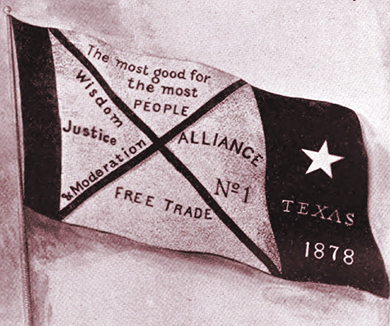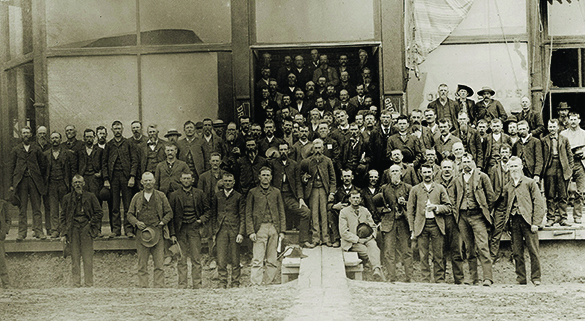| << Chapter < Page | Chapter >> Page > |

The alliance movement, and the subsequent political party that emerged from it, also featured prominent roles for women. Nearly 250,000 women joined the movement due to their shared interest in the farmers’ worsening situation as well as the promise of being a full partner with political rights within the group, which they saw as an important step towards advocacy for women’s suffrage on a national level. The ability to vote and stand for office within the organization encouraged many women who sought similar rights on the larger American political scene. Prominent alliance spokeswoman, Mary Elizabeth Lease of Kansas, often spoke of membership in the Farmers’ Alliance as an opportunity to “raise less corn and more hell!”
The Conner Prairie Interactive History Park discusses the role of women in rural America and how it changed throughout the end of the nineteenth century.
The alliance movement had several goals similar to those of the original Grange, including greater regulation of railroad prices and the creation of an inflationary national monetary policy. However, most creative among the solutions promoted by the Farmers’ Alliance was the call for a subtreasury plan. Under this plan, the federal government would store farmers’ crops in government warehouses for a brief period of time, during which the government would provide loans to farmers worth 80 percent of the current crop prices. Thus, farmers would have immediate cash on hand with which to settle debts and purchase goods, while their crops sat in warehouses and farm prices increased due to this control over supply at the market. When market prices rose sufficiently high enough, the farmer could withdraw his crops, sell at the higher price, repay the government loan, and still have profit remaining.
Economists of the day thought the plan had some merit; in fact, a greatly altered version would subsequently be adopted during the Great Depression of the 1930s, in the form of the Agricultural Adjustment Act. However, the federal government never seriously considered the plan, as congressmen questioned the propriety of the government serving as a rural creditor making loans to farmers with no assurance that production controls would result in higher commodity prices. The government’s refusal to act on the proposal left many farmers wondering what it would take to find solutions to their growing indebtedness.
Angry at the federal government’s continued unwillingness to substantively address the plight of the average farmer, Charles Macune and the Farmers’ Alliance chose to create a political party whose representatives—if elected—could enact real change. Put simply, if the government would not address the problem, then it was time to change those elected to power.
In 1891, the alliance formed the Populist Party , or People’s Party, as it was more widely known. Beginning with nonpresidential-year elections, the Populist Party had modest success, particularly in Kansas, Nebraska, and the Dakotas, where they succeeded in electing several state legislators, one governor, and a handful of congressmen. As the 1892 presidential election approached, the Populists chose to model themselves after the Democratic and Republican Parties in the hope that they could shock the country with a “third-party” victory.
At their national convention that summer in Omaha, Nebraska, they wrote the Omaha Platform to more fully explain to all Americans the goals of the new party ( [link] ). Written by Ignatius Donnelly, the platform statement vilified railroad owners, bankers, and big businessmen as all being part of a widespread conspiracy to control farmers. As for policy changes, the platform called for adoption of the subtreasury plan, government control over railroads, an end to the national bank system, the creation of a federal income tax, the direct election of U.S. senators, and several other measures, all of which aimed at a more proactive federal government that would support the economic and social welfare of all Americans. At the close of the convention, the party nominated James B. Weaver as its presidential candidate.

In a rematch of the 1888 election, the Democrats again nominated Grover Cleveland, while Republicans went with Benjamin Harrison. Despite the presence of a third-party challenger, Cleveland won another close popular vote to become the first U.S. president to be elected to nonconsecutive terms. Although he finished a distant third, Populist candidate Weaver polled a respectable one million votes. Rather than being disappointed, several Populists applauded their showing—especially for a third party with barely two years of national political experience under its belt. They anxiously awaited the 1896 election, believing that if the rest of the country, in particular industrial workers, experienced hardships similar to those that farmers already faced, a powerful alliance among the two groups could carry the Populists to victory.
Factors such as overproduction and high tariffs left the country’s farmers in increasingly desperate straits, and the federal government’s inability to address their concerns left them disillusioned and worried. Uneven responses from state governments had many farmers seeking an alternative solution to their problems. Taking note of the labor movements growing in industrial cities around the country, farmers began to organize into alliances similar to workers’ unions; these were models of cooperation where larger numbers could offer more bargaining power with major players such as railroads. Ultimately, the alliances were unable to initiate widespread change for their benefit. Still, drawing from the cohesion of purpose, farmers sought to create change from the inside: through politics. They hoped the creation of the Populist Party in 1891 would lead to a president who put the people—and in particular the farmers—first.

Notification Switch
Would you like to follow the 'U.s. history' conversation and receive update notifications?